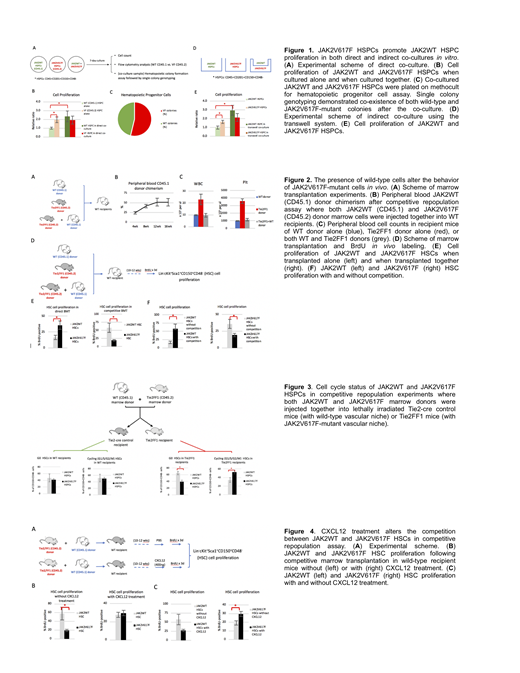Introduction
The myeloproliferative neoplasms (MPNs) are clonal stem cell disorders characterized by hematopoietic stem/progenitor cell (HSPC) expansion. The acquired kinase mutation JAK2V617F plays a central role in MPNs. Both JAK2 wild-type (WT) clones and JAK2V617F-mutant clones co-exist in many MPN patients. Little is known about earliest steps of MPN disease initiation and how the mutant cells expand over WT cells. In this work, we tested the hypothesis that competition between WT and JAK2V617F-mutant cells acts to prevent mutant cell expansion in MPNs, but that a JAK2V617F-bearing microenvironment can overcome this competition, leading to the development of a MPN.
Methods
JAK2V617F Flip-Flop (FF1) mice and Tie2-Cre mice were crossed to generate a strain in which human JAK2V617F is expressed specifically in hematopoietic cells and vascular endothelial cells (Tie2FF1).
Results
First, we isolated JAK2WT and JAK2V617F-mutant CD45+CD201+CD150+CD48- (here termed HSPCs) from either WT mice or Tie2FF1 mice and performed a series of in vitroco-culture assays. We found that JAK2V617F HSPCs displayed a higher proliferation rate than JAK2WT HSPCs when cultured separately. In contrast,when placed in direct co-culture, proliferation of JAK2WT HSPCs was greatly increased that no significant difference between WT and mutant HSPCs was detected. Similar results were also obtained when using a transwell co-culture system, suggesting that cell-cell contact was not required for the competitive co-existence we observed in mixed JAK2WT / JAK2V617F HSPC cultures in vitro. (Figure 1)
Next, we performed marrow transplantation assays to assess the competition between JAK2WT and JAK2V617F HSPCs in vivo. We found that, when 50% JAK2V617F marrow cells and 50% JAK2WT marrow cells were transplanted together into lethally irradiated WT mice, the JAK2V617F donor cells had no engraftment advantage over JAK2WT donor cells and the recipient mice had normal blood cell counts during more than 4-month follow up. This result contrasts our and other reports that a JAK2V617F-positive MPN develops following transplantation of 100% JAK2V617F-mutant donor cells into WT recipients. These observations suggest that the presence of WT cells can alterthe behavior of JAK2V617F-mutant stem cells in vivo. This conclusion was further supported by in vivoBrdU labeling experiments, which demonstrated that the proliferation rate of JAK2V617F-mutant Lin-cKit+Sca1+CD150+CD48-(here termed HSCs)was 2-fold higher than JAK2WT HSCs when transplanted separatelyinto lethally irradiated WT recipients; however, when transplanted together, WT HSCs displayed a significantly higher proliferation rate (3-fold) than mutant HSCs. (Figure 2)
Endothelial cells (ECs) are an essential component of the hematopoietic niche and many studies have established that a significant number of ECs in MPN patients carry the JAK2V617F mutation. Using the same Tie2FF1 murine model, we previously reported that a JAK2V617F-bearing vascular niche promotes the expansion of JAK2V617F HSPCs over JAK2WT HSPCs, and the level of Chemokine (C-X-C motif) ligand 12 (CXCL12) was upregulated in JAK2V617F-mutant ECs compared to WT ECs. Cell cycle analysis using Hoechst33342 and Pyronin Y staining demonstrated that, while there were no differences in WT and mutant HSPC cell cycle status when transplanted into a WT vascular niche, JAK2V617F-mutant HSPCs were less quiescent (more cycling) than WT HSPCs when transplanted into a JAK2V617F-mutant vascular niche. (Figure 3) To test the hypothesis that JAK2V617F-mutant vascular niche overcomes the competition between WT and mutant cells to promote mutant HSPC expansion through increased CXCL12 level, we used the same competitive repopulation assay as in Figure 2 where both JAK2WT and JAK2V617F marrow cells were injected together into lethally irradiated WT recipient. At 12wks post transplantation, the recipient mice were treated with a single dose of CXCL12 (400ng, intravenously) before BrdU labeling. We found that CXCL12 treatment stimulated JAK2V617F-mutant HSC proliferation to a greater extent than JAK2WT HSPCs. (Figure 4)
Conclusions
Cell competition between WT and JAK2V617F-mutant cells prevents mutant stem cells from expansion, but a mutant microenvironment (e.g. JAK2V617F-mutant vascular niche) can overcome this competition to promote mutant stem cell expansion and the development of a murine MPN.
No relevant conflicts of interest to declare.
Author notes
Asterisk with author names denotes non-ASH members.


This feature is available to Subscribers Only
Sign In or Create an Account Close Modal